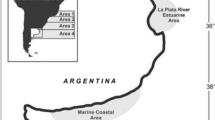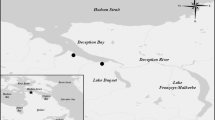Abstract
Hagfish, the plesiomorphic sister group of all vertebrates, are scavengers, and many of them live at depths reaching thousands of meters. They are caught for use as food and serve as a substitute for leather in crafts in Asian hagfisheries. At present, the amount of various pollutants present in hagfishes from bioaccumulation through the food chain is unknown. To understand the bioaccumulation characteristics of heavy metals in deep-sea scavengers, selected heavy metals, including iron (Fe), manganese (Mn), copper (Cu), zinc (Zn), arsenic (As), selenium (Se), cadmium (Cd), mercury (Hg), and lead (Pb), were analyzed and compared in two hagfish species, Paramyxine nelsoni (Pn) (found at approximately 200 m) and Myxine formosana (Mf) (found at approximately 850 m) caught in southwestern Taiwanese waters. Hagfish muscle (PnM and MfM) and liver (PnL and MfL) samples were lyophilized, and their metal levels were then analyzed using an inductively coupled plasma mass spectrometer. The metals with the highest levels in Pn tissues included Cu and As (PnL > MfL and PnM > MfM); in contrast, those that were higher in Mf tissues were Cd, Hg (both MfL > PnL and MfM > PnM), and Zn (MfM > PnM). Multivariate analyses, i.e., principle component analysis and partial least squares for discriminant analysis of metal levels were able to clearly separate these four tissue types into two groups corresponding to the two species: Pn and Mf. The present data also show differences in the levels of certain heavy metals in these tissues of the two hagfish species. These differences might have resulted not only from depth-related environmental factors but also from different species’ accumulation characteristics. Fe, Cu, and Hg concentrations were much higher in hagfish muscle than have been found in other fishes from adjacent polluted regions, and Hg was approximately 10- to 100-fold higher in hagfish muscles. Public health issues related to the consumption of hagfish are also discussed.






Similar content being viewed by others
References
Bagatto G, Alikhan MA (1987) Copper, cadmium, and nickel at Sudbury, Ontario, Canada. Bull Environ Contam Toxicol 38:540–545
Brown FMJ, Balls PW (1997) Trace metals in fish and shellfish from Scottish waters. Scot Fish Res Rep 60:1–36
Canli M, Atli G (2003) The relationships between heavy metal (Cd, Cr, Cu, Fe, Pb, Zn) levels and the size of six Mediterranean fish species. Environ Pollut 121:129–136
Caurant F, Amiard-Triquet C, Amiard JC (1993) Factors influencing the accumulation of metals in pilot whales (Globicephala melas) off the Faroe Islands. Rep Int Whal Commn 14:369–390. Special issue
Caurant F, Amiard JC, Amiard-Triquet C, Sauriau PG (1994) Ecological and biological factors controlling the concentrations of trace elements (As, Cd, Cu, Hg, Se, Zn) in Delphinids Globicephala melas from the North Atlantic Ocean. Mar Ecol Prog Ser 103:207–219
Caurant F, Navarro M, Amiard JC (1996) Mercury in pilot whales: possible limits to the detoxification process. Sci Total Environ 186:95–104
Chen HC (2002a) Study on the pollution status and recycling of coastal fishery resource II-Chiayi and southwestern coastal area. 91-AS-1.4.3-F-F1. Council of Agriculture, Taiwan, ROC
Chen MH (2002b) Baseline metal concentrations in sediments and fish, and the determination of bioindicators in the subtropical Cigu Lagoon, S.W. Taiwan. Mar Pollut Bull 44:703–714
Chen YC, Chen MH (2001) Heavy metal concentrations in nine species of fishes caught in coastal waters off Ann-Ping, S.W. Taiwan. J Food Drug Anal 9:107–114
Chen CT, Kandasamy S (2008) Evaluation of elemental enrichments in surface sediments off southwestern Taiwan. Environ Geol 54:1333–1346
Chen CM, Lee SZ, Wang JS (2000) Metal contents of fish from aquaculture ponds near scrap metal reclamation facilities. Chemosphere 40:65–69
Chen YC, Chen CY, Huang HJ, Chang WB, Chen MH (2004) Comparison of the metal concentrations in muscle and liver tissues of fishes from Erren River, Southwestern Taiwan, after the restoration in 2000. J Food Drug Anal 12:358–366
Codex Alimentarius Commission (1984) Contaminants: Joint FAO/WHO standards program, vol. XVII, 1st edn. Codex Alimentarius, Rome, Italy, pp 1–33
Cronin M, Davies IM, Newton A, Pirie JM, Topping G, Swan SC (1998) Trace metal concentrations in deep-sea fish from the North Atlantic. Mar Environ Res 45:225–238
Das YK, Aksoy A, Baskaya R, Duyar HA, Guvenc D, Boz V (2009) Heavy metal levels of some marine organisms collected in Samsun and Sinop coasts of Black Sea in Turkey. J Anim Vet Adv 8:496–499
Douben PE (1989) Lead and cadmium in stone loach (Noemacheilus barbatulus L.) from three rivers in Derbyshire. Ecotoxicol Environ Safe 18:35–58
Fernholm B (1998) Hagfish systematics. In: Jørgensen JM, Lomholt JP, Weber RE, Malte H (eds) The biology of hagfishes. Chapman & Hall, London, pp 33–44
Gordon JDM, Merrett NR, Haedrich RL (1995) Environmental and biological aspects of slope dwelling fishes of the North Atlantic. Deep-water fisheries of the North Atlantic oceanic slope. In: Hopper AL (ed) Proceedings of the NATO Advanced Research Workshop on deepwater fisheries of the north Atlantic Slop. Kluwer, Amsterdam, pp 1–27
Gustafason G (1935) On the biology of M. glutinosa L. Ark Zool 28A:1–8
Heath AG (1987) Water pollution and fish physiology. CRC Press, Boca Raton, FL
Honma Y (1983) A story of the fisheries of hagfish and sea lamprey in the waters of Sado and Awashima islands, the Sea of Japan. Can Trans Fish Aquat Sci 50:1–6
Hung JJ, Hsu CL (2004) Present state and historical changes of trace metal pollution in Kaoping coastal sediments, southwestern Taiwan. Mar Pollut Bull 49:986–998
Hung TC, Huang CC, Meng PJ, Chuang A, Wu SJ (1999) Heavy metals in fish tissues and different species of fish from the southern coast of Taiwan. Chem Ecol 16:283–296
Koeman JH, Peeters WHM, Koudstaal-Hol CHM, Tjioe PS, De Goeij JJM (1973) Mercury–selenium correlations in marine mammals. Nature 245:385–386
Langston WJ (1990) Toxic effects of metals and the incidence of marine ecosystems. In: Furness RW, Rainbow PS (eds) Heavy metals in the marine environment. CRC Press, New York
Lee CL, Fang MD, Hsieh MT (1998) Characterization and distribution of metals in surficial sediments in southwestern Taiwan. Mar Pollut Bull 36:447–464
Lee YH, Huang HT, Mok HK (2007) Microscopic structure and digital morphometric analysis of the statoconia of hagfish, P. nelsoni (Myxiniformes). Zool Stud 46:1–5
Lin MS, Hung JJ (1992) Terrigenous inputs and sedimentary fluxes of heavy metals off southwestern Taiwan. Soc Mar Sci Technol 10:36–46
McMillan CB, Wisner RL (2004) Review of the hagfishes (Myxinidae, Myxiniformes) of the northwestern Pacific Ocean, with descriptions of three new species, Eptatretus fernholmi, P. moki, and P. walkeri. Zool Stud 43:51–73
Mok HK, Chen YW (2001) Distribution of hagfish (Myxinidae:Myxiniformes) in Taiwan. Zool Stud 40:233–239
Mok HK, Kuo CH (2001) Myxine formosana, a new species of hagfish (Myxiniformes: Myxinidae) from the southwestern waters of Taiwan. Ichthyol Res 48:295–297
Mormede S, Davies IM (2001) Heavy metal concentrations in commercial deep-sea fish from the Rockall Trough. Cont Shelf Res 21:899–916
Nakayama SMM, Ikenaka Y, Muzandu K, Choongo K, Oroszlany B, Teraoka H et al (2010) Heavy metal accumulation in lake sediments, fish (Oreochromis niloticus and Serranochromis thumbergi), and crayfish (Cherax quadricarinatus) in Lake Itezhi-tezhi and Lake Kariba, Zambia. doi:10.1007/s00244-010-9483-8
National Research Council (1989) Recommended dietary allowances, 10th edn. National Academy Press, Washington
Pan WH, Chang YH, Chen JY, Wu SJ, Tzeng MS, Kao MD (1999) Nutrition and health survey in Taiwan (NAHSIT) 1993–1996: dietary nutrient intakes assessed by 24-hour recall. Nutr Sci J 24:11–39
Roesijadi G, Robinson WE (1994) Metal regulation in aquatic animals: mechanism of uptake, accumulation and release. In: Malins DC, Ostrander GK (eds) Aquatic toxicology (molecular, biochemical and cellular perspectives). Lewis, London, pp 387–420
Tepe Y, Türkmen M, Türkmen A (2008) Assessment of heavy metals in two commercial fish species of four Turkish seas. Environ Monit Assess 146:277–284
Varanasi U, Markey D (1978) Uptake and release of lead and cadmium in skin and mucus of coho salmon (Oncorhynchus kistch). Comp Biochem Physiol C 60:187–191
Worthington J (1905) Contribution to our knowledge of the myxinoids. Am Nat 39:625–662
Acknowledgments
This research was supported by a National Science council grant (Grant No. NSC96-2621-B-110-003-MY3) to H. K. M. We thank S. J. Jiang of the Chemistry Department and Joint Center for High Valued Instruments and National Sun Yat-Sen University for helping with the heavy-metal analyses. We also appreciate Y.C. Liu and H. Lee-Lin for their assistance at refining the figure drawings.
Author information
Authors and Affiliations
Corresponding author
Rights and permissions
About this article
Cite this article
Chiu, KH., Mok, HK. Study on the Accumulation of Heavy Metals in Shallow-Water and Deep-Sea Hagfishes. Arch Environ Contam Toxicol 60, 643–653 (2011). https://doi.org/10.1007/s00244-010-9572-8
Received:
Accepted:
Published:
Issue Date:
DOI: https://doi.org/10.1007/s00244-010-9572-8




